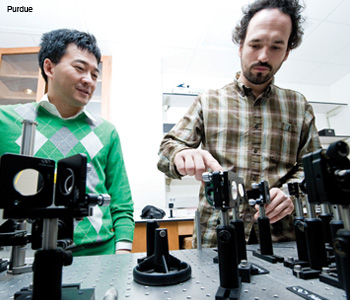Scatterings
Lasers Sort Carbon Nanotubes
Researchers at Purdue University report that transient-absorption spectroscopy can be used to quickly sort nanotubes based on how they conduct charge.
 Researchers Ji-Xin Cheng, left, an associate professor of biomedical engineering and chemistry, and biomedical engineering research scientist Mikhail N. Slipchenko at Purdue, developed a laser-sorting method that separates semiconducting carbon nanotubes from metallic ones.
Researchers Ji-Xin Cheng, left, an associate professor of biomedical engineering and chemistry, and biomedical engineering research scientist Mikhail N. Slipchenko at Purdue, developed a laser-sorting method that separates semiconducting carbon nanotubes from metallic ones.
Laser pump-probe experiments may be just what nanoelectronics needs, providing a way to sort single-walled carbon nanotubes by how they conduct charge. Semiconducting single-walled carbon nanotubes (which are basically rolled bundles of graphene) offer a lot of promise as components in future electronics. They have the potential to provide smaller, faster and more efficient systems than the silicon circuitry used today. One obstacle for the technology, however, is that making semiconductor nanotubes also creates metallic nanotubes. The difficulty of separating the (semiconductor) wheat from the (metallic) chaff has limited both their electronic and photonic applications thus far.
…Log in or become a member to view the full text of this article.
This article may be available for purchase via the search at Optica Publishing Group.
Optica Members get the full text of Optics & Photonics News, plus a variety of other member benefits.
